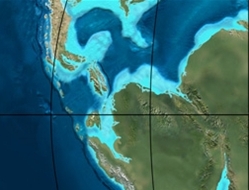Top Qs
Timeline
Chat
Perspective
Guavio Formation
Geologic formation in Colombia From Wikipedia, the free encyclopedia
Remove ads
The Guavio Formation (Spanish: Calizas del Guavio, Kicg) is a geological formation of the Altiplano Cundiboyacense, Eastern Ranges of the Colombian Andes. The formation consists of conglomerates, shales and limestones, dates to the Late Jurassic and Early Cretaceous periods; Tithonian to Berriasian epochs and has a maximum thickness of 1,000 metres (3,300 ft).
Remove ads
Etymology
The formation was defined and named in 1976 by Rodríguez and Ulloa after the Guavio River, Cundinamarca.[1]
Description
Lithologies
The Guavio Formation has a maximum thickness of 1,000 metres (3,300 ft), and is characterised by a sequence of conglomerates, shales and limestones.[1]
Stratigraphy and depositional environment
The Guavio Formation, the lowermost unit of the Cáqueza Group, overlies the Batá Formation and is overlain by the Macanal Formation. The unit is subdivided into five members, from old to younger; Conglomerado de Miralindo, Lutitas de Miralindo, Caliza de Malacara, Lutitas de Las Mercedes and Caliza de Las Mercedes. The age has been estimated to be Tithonian to Berriasian, spanning the Jurassic-Cretaceous boundary. Stratigraphically, the formation is time equivalent with the Arcabuco Formation. The formation has been deposited in a shallow marine environment in an oxygen-poor basin.[1]
Remove ads
Outcrops
The Guavio Formation is apart from its type locality at the Alto de Miralindo and Cuchilla de Manizales, found near Gachalá and Medina.[1]
See also
References
External links
Wikiwand - on
Seamless Wikipedia browsing. On steroids.
Remove ads


